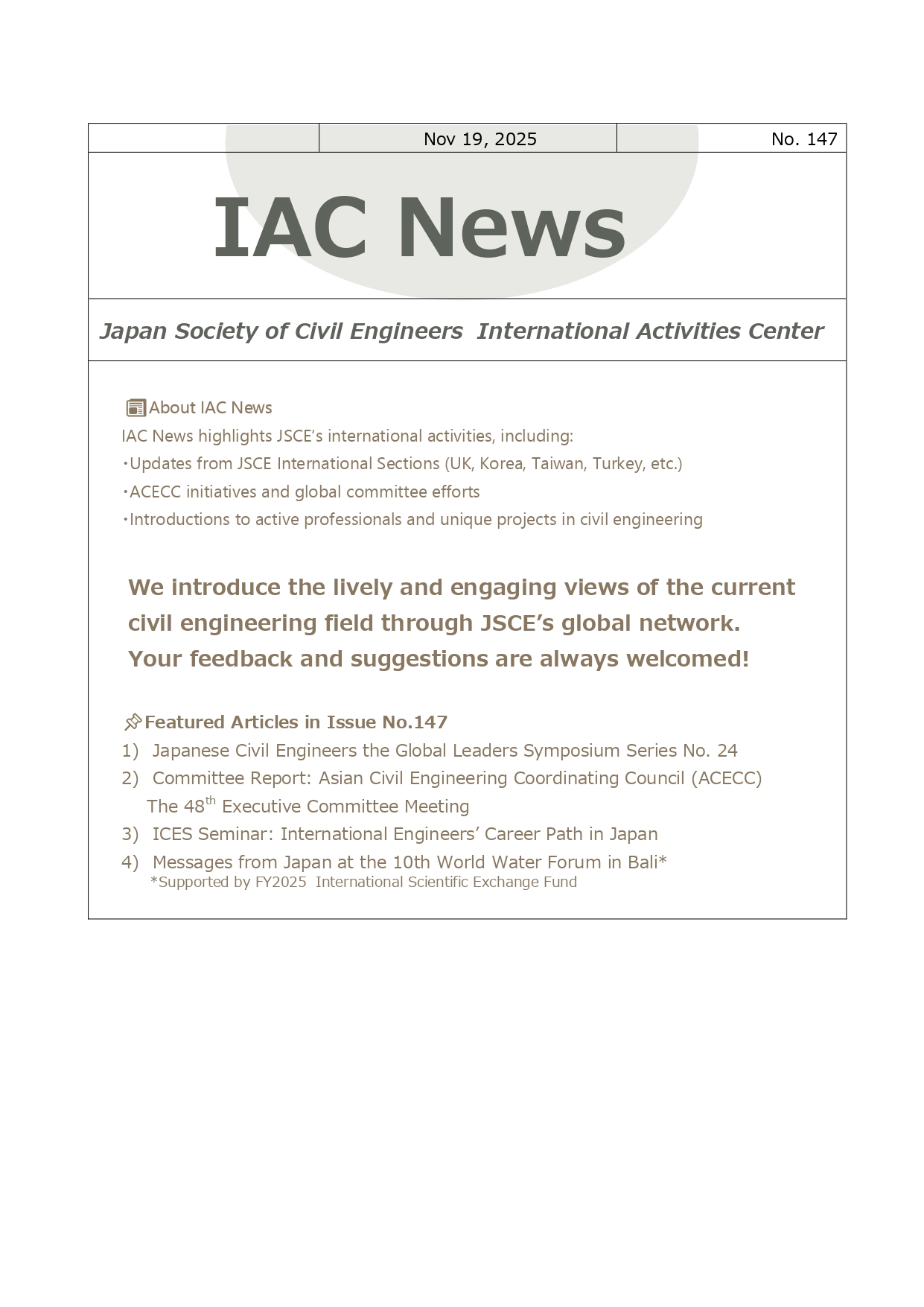2013 Outstanding Civil Engineering Achievement Award
[Group-1]
| 1. Construction of the Largest Cross Section Road Tunnel in Japan with Bifurcation in Unconsolidated “Shirasu” Ground |
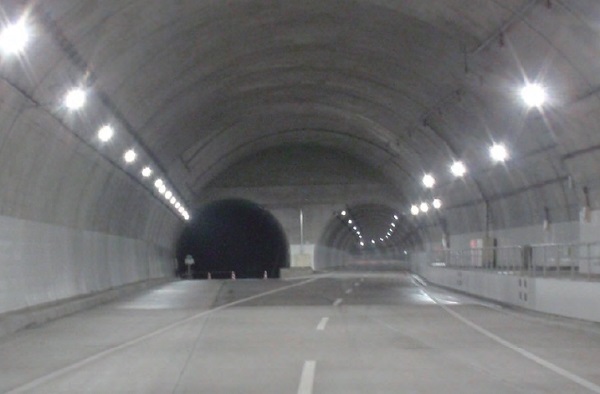 |
|
・Ministry of Land, Infrastructure, Transport and Tourism, Kyusyu Regional Development Bureau, Kagoshima National Road Office |
|
Shin-Takeoka Tunnel is 1,514m length, constructed by NATM. |
| 2. Construction technique of large underground station and tunnels in Bosphorus strait railway tunnel connecting Asia and Europe |
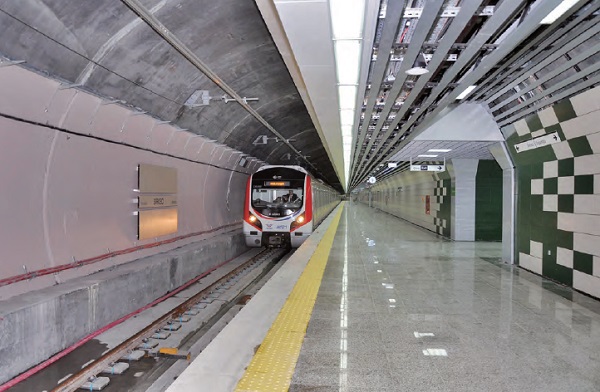 |
| ・Taisei Corp. |
| Marmaray project is the construction project of Bosphorus strait railway tunnel connecting Asia and Europe in Istanbul, Turkey. Sirkeci station is the underground station below a high density residential area at the center of historic district in Istanbul, which has so complicated configuration with combination of many types of tunnels. To complete construction of Sirkeci station under severe conditions, many different types of tunneling techniques developed in Japan was extensively used. Success of this construction would spread not only a high reputation of Japanese tunneling technique, but also would provide a new opportunity to extend other similar international projects for underground developments. |
| 3. Rapid Construction of Parallel Road Tunnels by Oval Shaped Shield TBM, Overcoming Extremely Shallow Earth Cover and Small Tunnel Clearance -Construction of Kawajiri Tunnel on Sagami Longitudinal Expressway- |
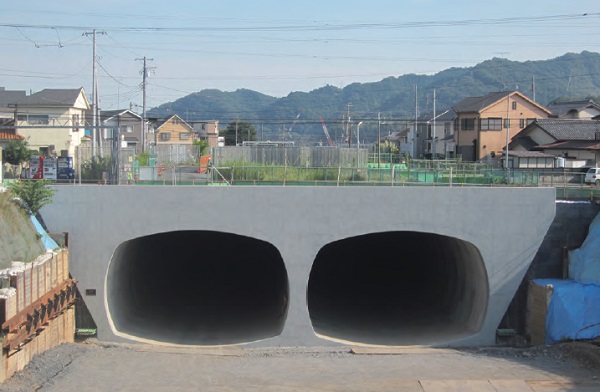 |
| ・Sobu National Highway Office, ・Kanto Regional Development Bureau, ・Ministry of Land, Infrastructure, Transport and Tourism ・OBAYASHI Corp. |
| Kawajiri Tunnel on Sagami Longitudinal Expressway is 417m long road tunnel in quiet residential area, a part of Metropolitan Inter-City Expressway. Considering impact on environment, shield tunneling method was adopted for the construction of this tunnel. New technologies such as 1.Shield tunneling with departure and arrival of TBM on the ground surface, 2.Adoption of oval section, 3.Open shield TBM equipped with system to reduce surrounding ground movement, 4.Constructon of parallel tunnels with 20cm clearance, have enabled to apply shield tunneling method for the extremely shallow tunnel construction in urban area where conventionally cut and cover method is applied. This project achieved shortening construction period drastically and remarkably reduced quantity of excavation. |
| 4. Flood Control in the Yodo River System during the Typhoon No.18, 2013 - Prevented Catastrophic Damage through Integrated and Collaborative Operations at Seven Dams and a Barrage - |
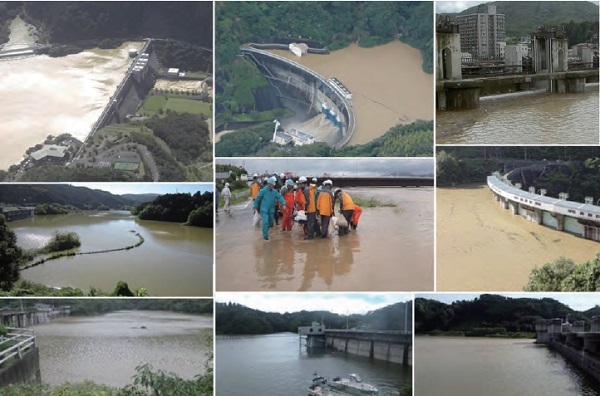 |
| ・Kinki Regional Development Bureau, Yodogawa Integrated Dam Control Office, and Biwako Office, Ministry of Land, Infrastructure, Transport and Tourism (MLIT), ・Kansai Regional Bureau, Hiyoshi Dam Control and Management Office, Kizugawa Integrated Dam Control and Management Office, and Lake Biwa Management Office, Incorporated Administrative Agency Japan Water Agency (JWA) |
| Catastrophic damage was prevented through the integrated and collaborative operations at seven dams and a barrage in the Yodo river system during the Typhoon No.18, 2013. The anticipated levee breach in the lower reach of the Katsura river was avoided due to the great efforts in flood fighting that were deployed, which resulted in only some ten-odd-centimeter depth of overtopping. The maximum available capacity was utilized at the Hiyoshi dam, an upstream dam, which prevented inundation of 13,000 properties and 1.2 trillion yen of flood damage. Throughout the rivers in the system, operations at seven dams and a barrage also significantly contributed to lower river levels at the confluence of these rivers, including the levels of the Katsura, which ensured a decrease of tens of centimeters in overflow water levels. |
| 5. Confirmation of durability and soundness of the Seikan Tunnel |
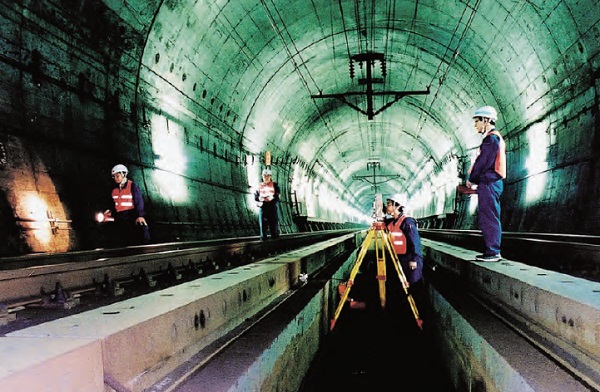 |
| ・Hokkaido Shinkansen Construction Bureau, Railway Construction Headquarters, Japan Railway Construction, Transport and Technology Agency(JRTT) ・Hokkaido Railway Company |
| Seikan Tunnel is the longest undersea tunnel in the world, 53.85km long, connecting Honshu and Hokkaido across the Tsugaru Strait. Under the special environment of undersea such as high water pressure and high salinity, it is quite important to secure a good condition at the tunnel and surrounding grout in a long term. We have conducted surveys and measurements of the grouting area, shotcrete and concrete lining since its opening in March 1988. In this study, durability and soundness of the structure is confirmed from observed results towards the opening of the Hokkaido Shinkansen in 2016. |
| 6. The construction of Tohoku-Jukan line - Erection of decks and piers just above the in-service Shinkansen line, and seismic reinforcement existing Shinkansen structures - |
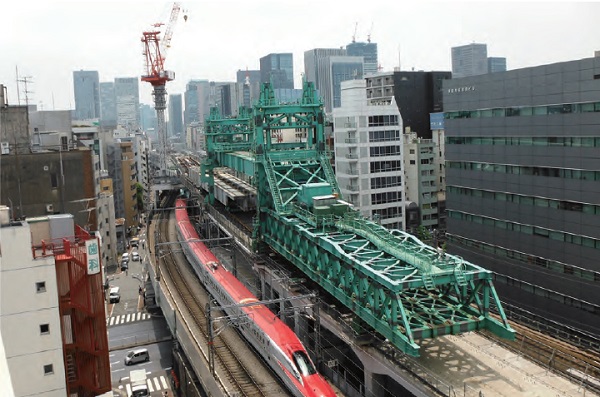 |
| ・East Japan Railway Company Tokyo construction office ・KAJIMA CORPORATION |
| We have implemented the project which connects the several separated radiate railway lines to newline “Tohoku-Jukan line”. This line is now under construction just above the in-service Shinkansen line, because it is very difficult to obtain the space for new line in urban area of Japan. The construction is realized by applying the viaduct structures with double-deck system, which consists of the existing viaducts for Shinkansen and new decks and new piers for the new line added on the steel rigid-frame piers of existing viaducts. To resist additional load, existing viaducts are reinforced for anti-earthquake in very narrow space. And new decks and new piers are constructed by 100t crane in short quiet hours of Shinkansen line. |
[Group-2]
| 1. Protection project against high tide in Natsui district in Fukushima prefecture.-New type of seawall maintenance with the rational utilization of disaster waste- |
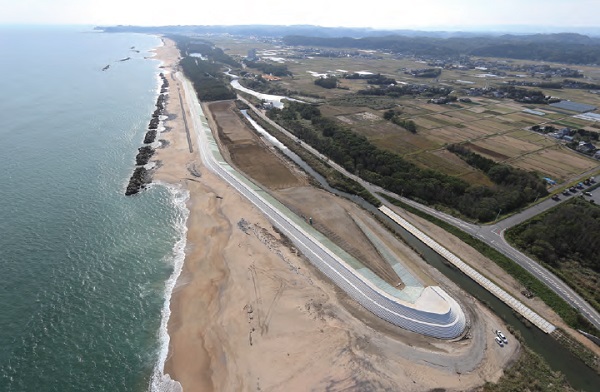 |
| ・Fukushima Prefecture |
|
Construction of seawalls in Natsui district is focused on reconstruction projects to recover from the Great East Japan Earthquake. |
| 2. Construction of Okukubi Dam Application of a trapezoid CSG dam to be constructed under particular conditions such as that the construction area is within subtropical islands region, fresh & sea water mingling zone and the US base. |
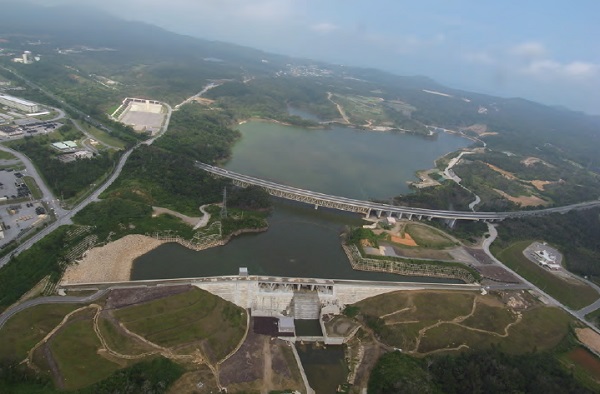 |
| ・North Dams Construction Office Okinawa General Bureau Cabinet Office G.O.J |
| Most of the construction area of Okukubi dam is within the US base. The area has rich environment such as subtropical islands region where fresh and sea water are mingled and mangrove forests and coral reef grow. Moreover, there is a historic heritage, “Shukumichi” in the downstream area. The construction work was carried out under severe conditions required by the US base, aiming low cost by applying trapezoid CSG dam and environmental friendly execution. This work is a redevelopment work executed by overwhelming special conditions, applying new engineering, considering environmental impacts and meeting the social and contemporary requirements. |
| 3. Japanese first hydraulic containment type LPG underground storage cavern at EL.-150m. –Constructions of Namikata and Kurashiki national stockpile bases- |
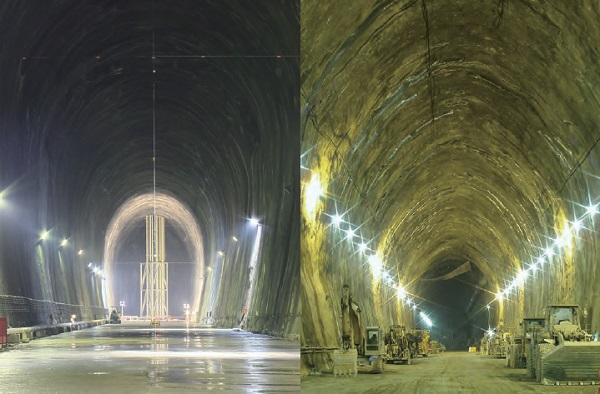 |
| ・Japan Oil, Gas and Metal National Corp. ・Tokyo Electric Power Service Co., Ltd. ・Kajima Corp. ・Shimizu Corp. ・Taisei Corp. ・Obayashi Corp. |
| Japan Oil, Gas and Metal National Corporation have constructed the world’s largest hydraulic containment type LPG storage caverns in Kurashiki and Namikata to complete the 1,500,000 tons national stockpile. Considering the applicability of water curtain system on the heterogeneous hydrogeological characteristics in Japan, Kurashiki and Namikata projects apply the observational groundwater control method on cavern excavation. Also, high performance of cavern air-tightness was verified by utilizing high accuracy measurement instruments. The constructions have contributed greatly on the development of Japanese design/construction technologies, the contribution is eligible for the 2014 Technology Award of Japan Society of Civil Engineers. |
| 4. The achievement of large railway network on capital region -The project of construction Tokyu-Toyoko-line to underground between Shibuya and Daikanyama - |
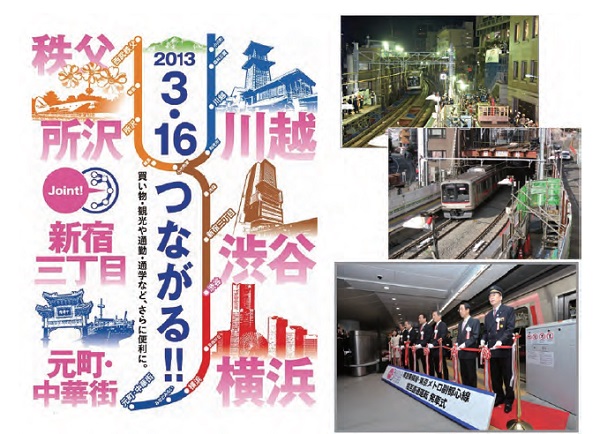 |
| ・Tokyu Corp. |
|
The project of construction Tokyu-Toyoko-line to underground between Shibuya and Daikanyama is for available of mutual direct connecting 5company’s railway. In the tunneling is a high degree of difficulties in crossing national main road and JR-line with right under of operating Tokyu-Toyoko-line. There are two features of technics. (1)It is adopted square section to avoiding bad influence for railway bridge, and tunneling during day and night is advanced on severe management of measuring. (2)A special method called ‘STRUM’is adopted for switching track rail. While removing and moving beams, we successed it only 3hours and 25minutes without any urban transport accident. This project triggered off regeneration and development of Shibuya area. |
| 5. Temporary restoration of JR Kesennuma line and JR Ofunato line by introducing BRT(Provision of local transport service to contribute to restoration of the areas affected by the disaster) |
 |
| ・East Japan Railway Company |
| To restore the areas affected by The Great East Japan Earthquake on March 11, 2011, BRT (Bus Rapid Transit) project could provide safety and convenient local transport service immediately after the disaster. Introduction of BRT system has several benefits for passengers. For example, while constructing the dedicated BRT motorways, BRT system already could start to operate by driving normal roads. Second, dedicated BRT motorways which have been reformed from the disaster-stricken railway realized punctual operation. Third, it is easy for BRT vehicle to change its driving route so that the vehicle can evacuate much easier than train when coming of tsunami. We believe that BRT system, which is convenient, sustainable, and high quality public transportation system, may also be introduced in aging areas. |

